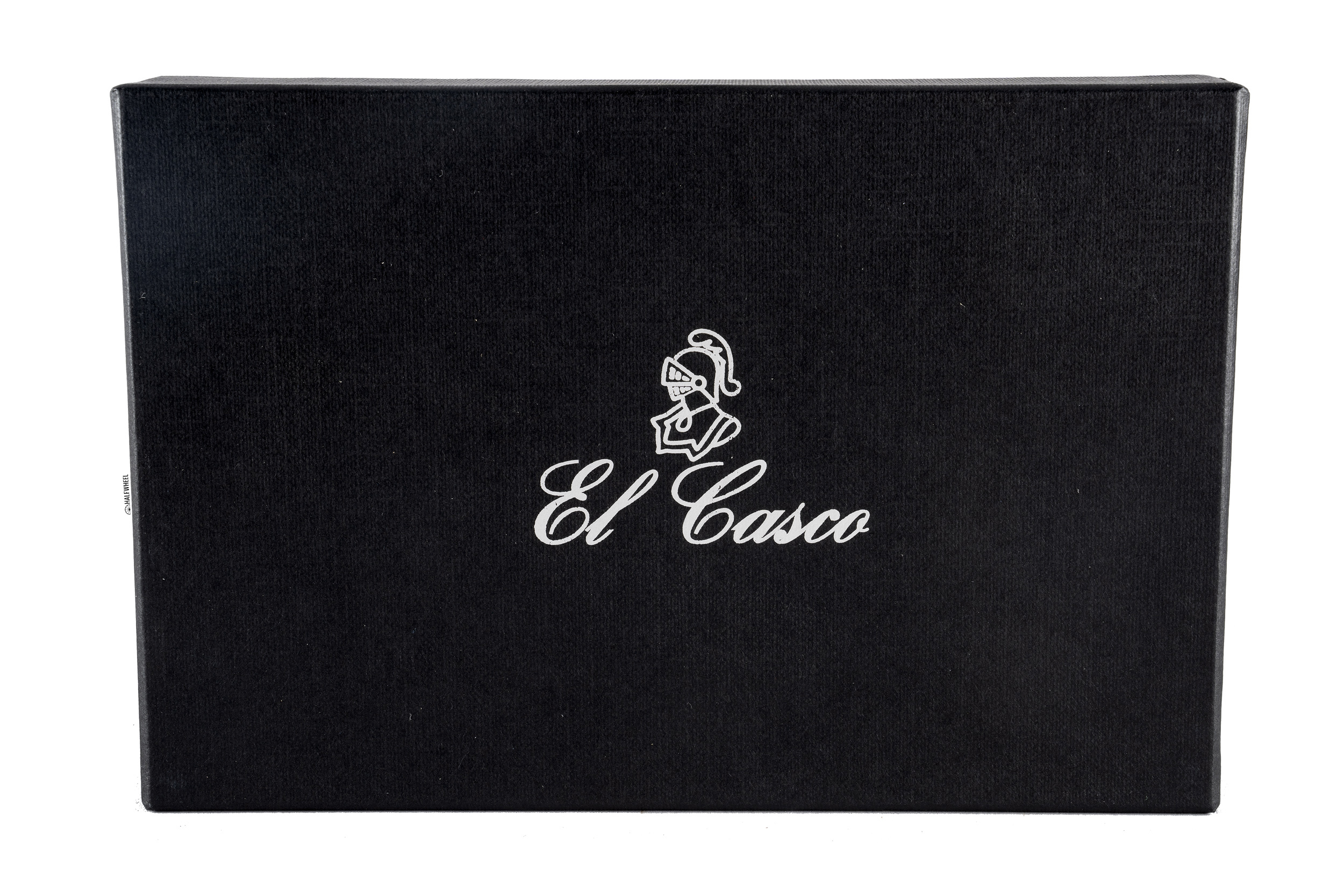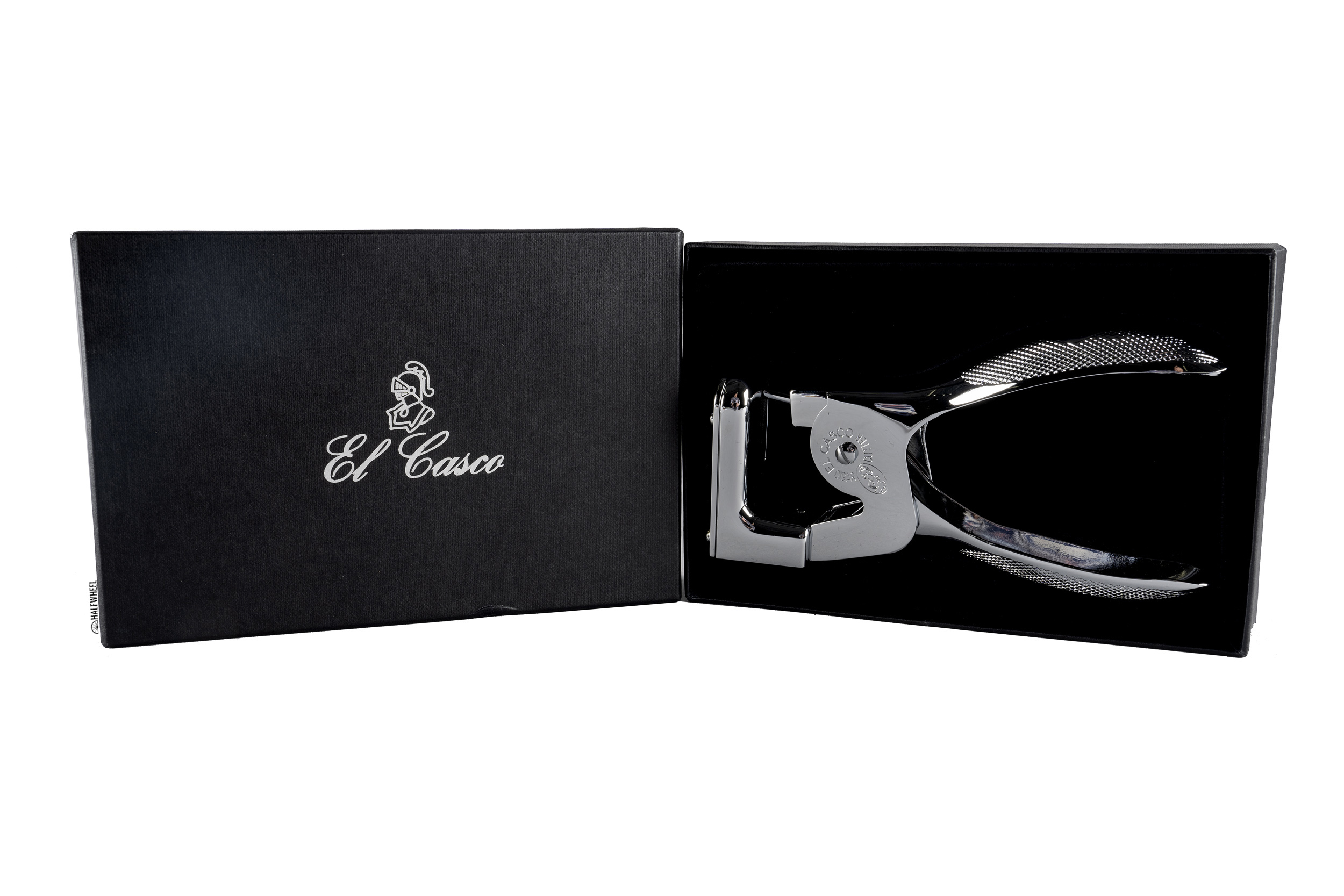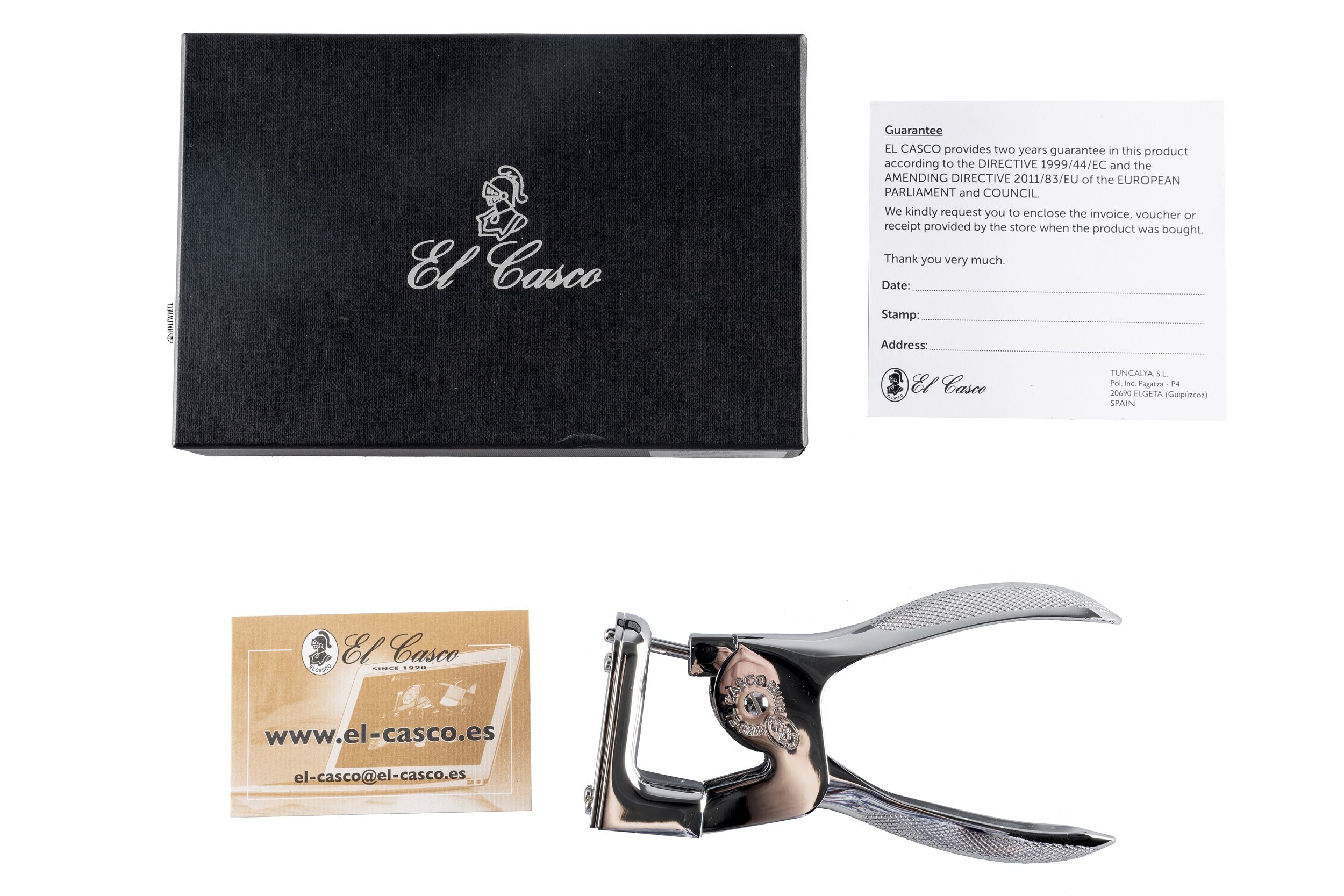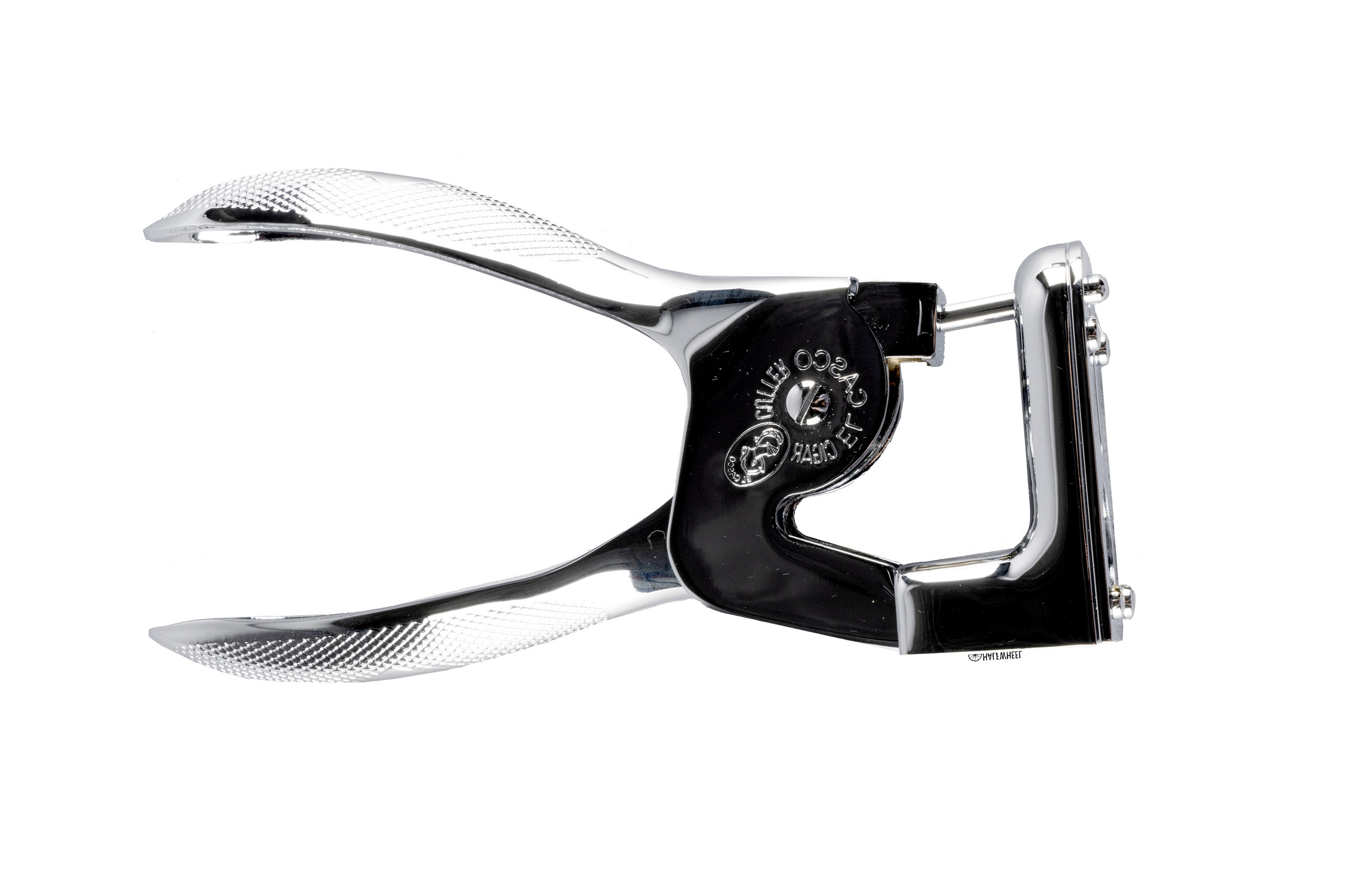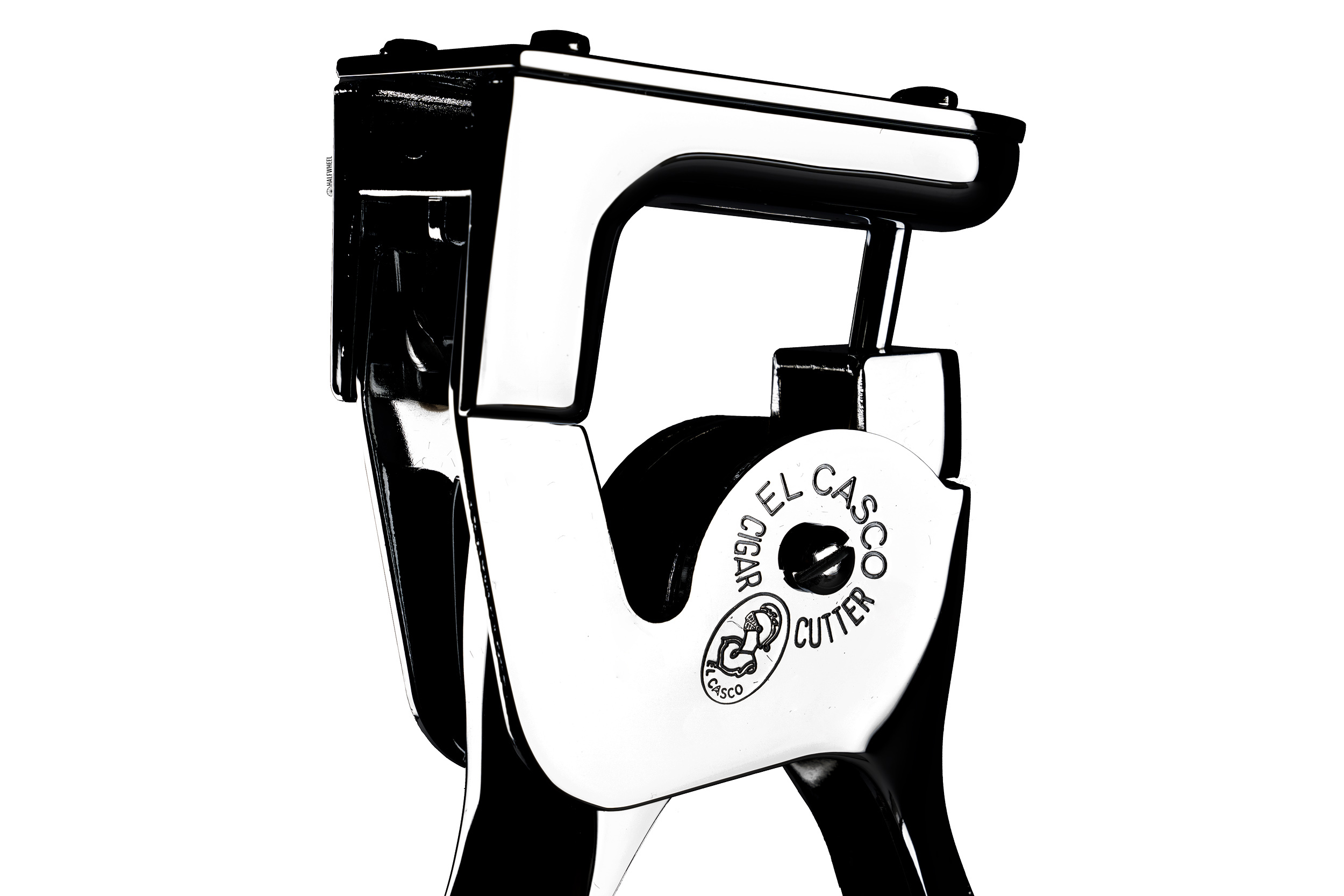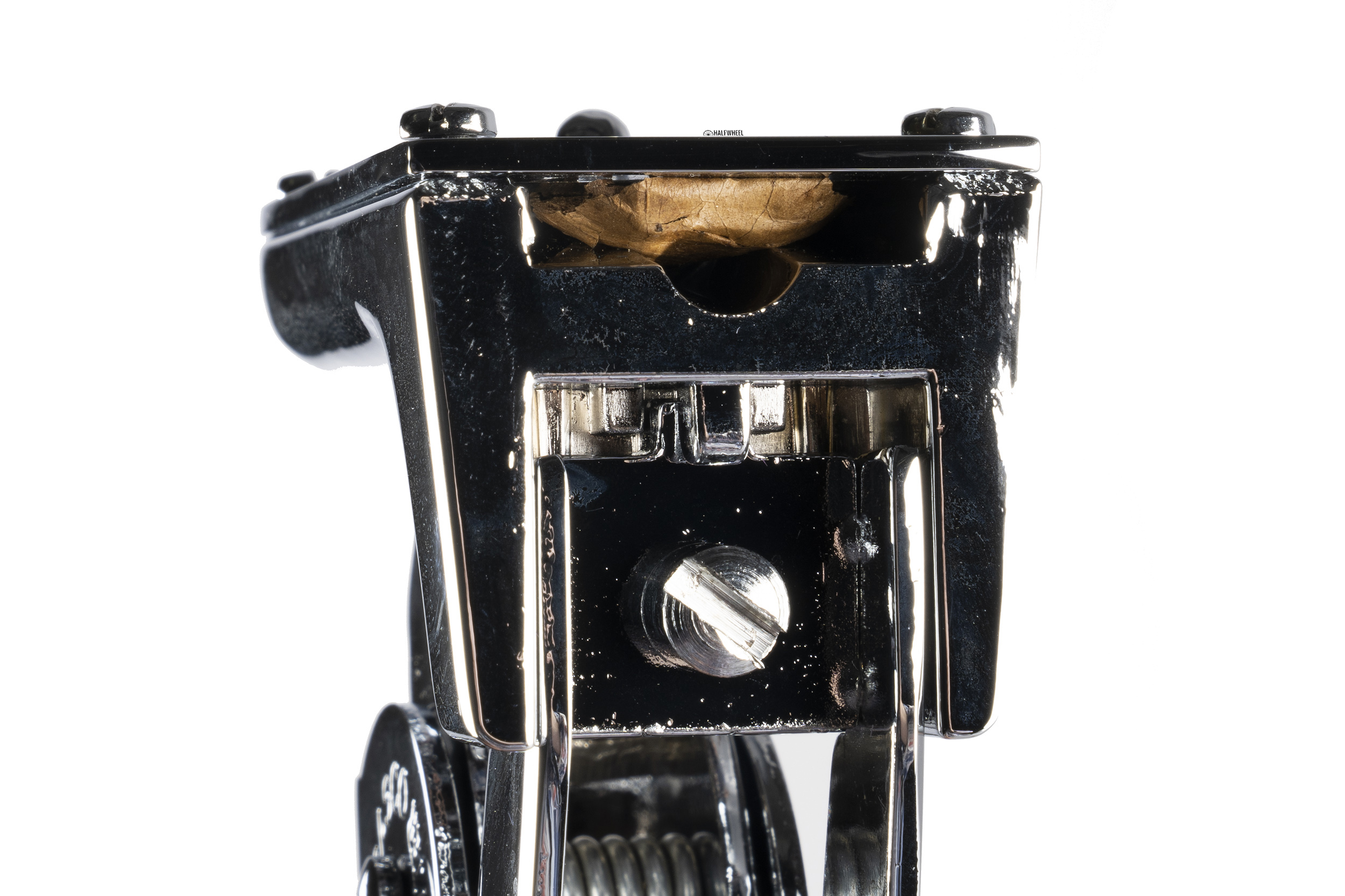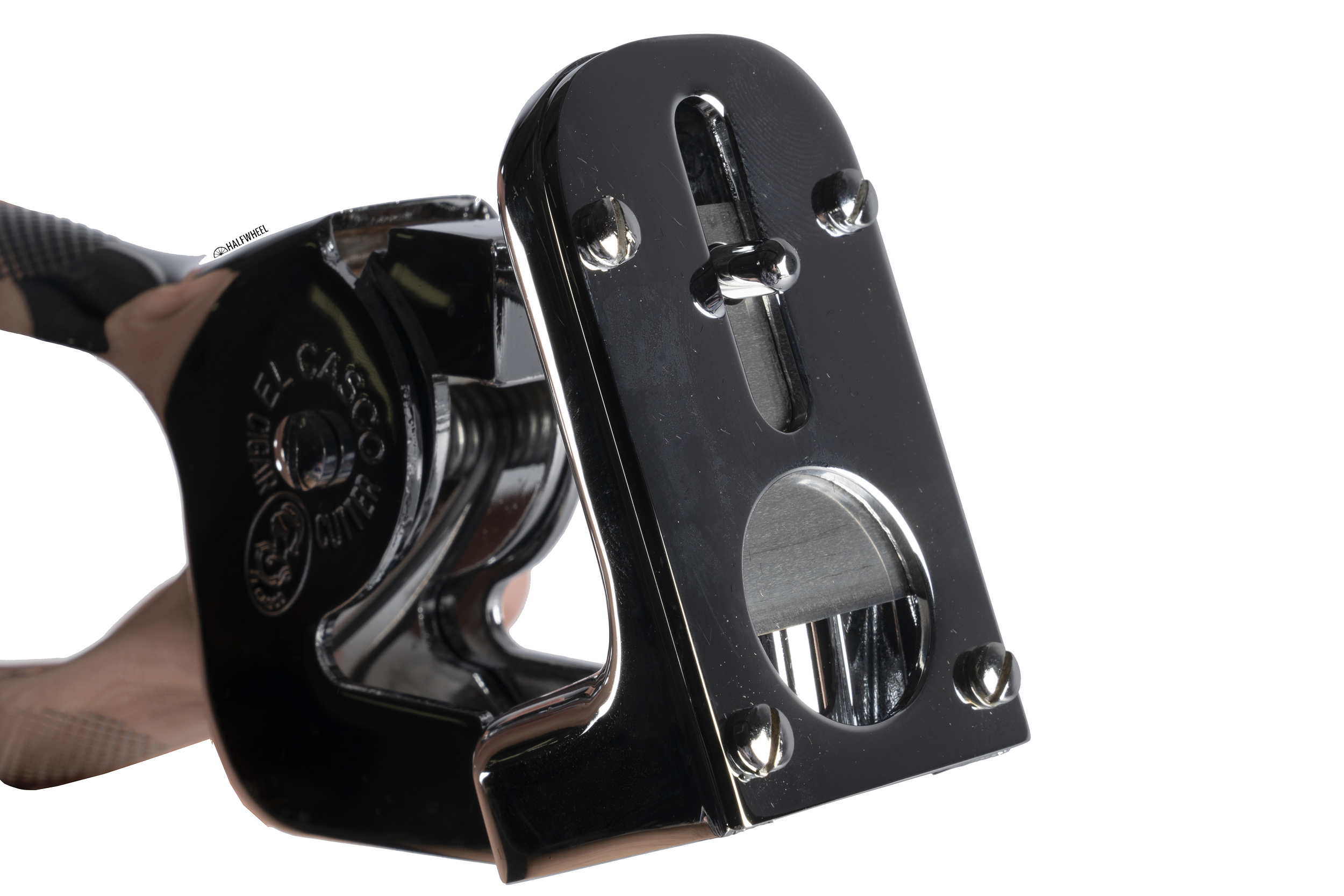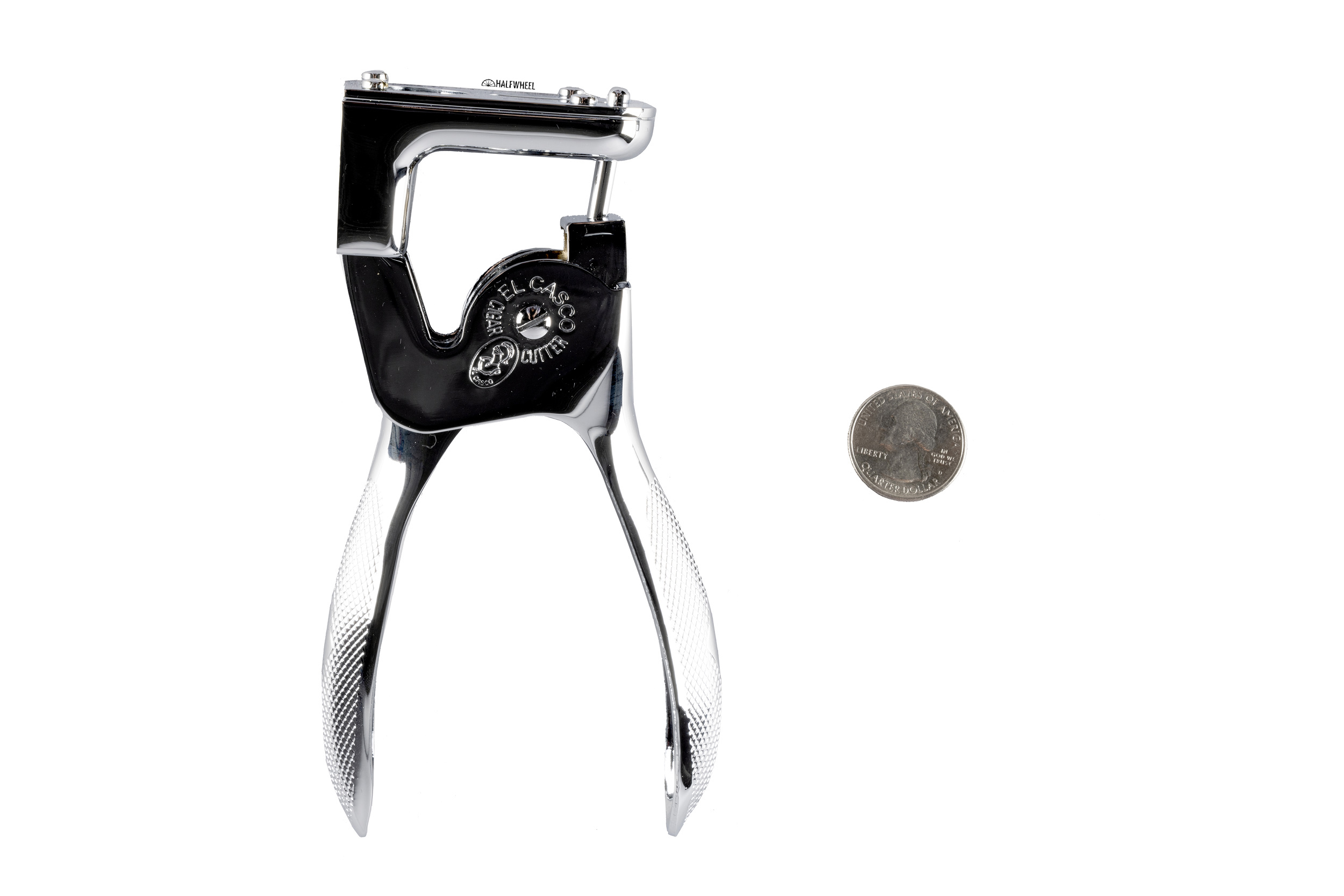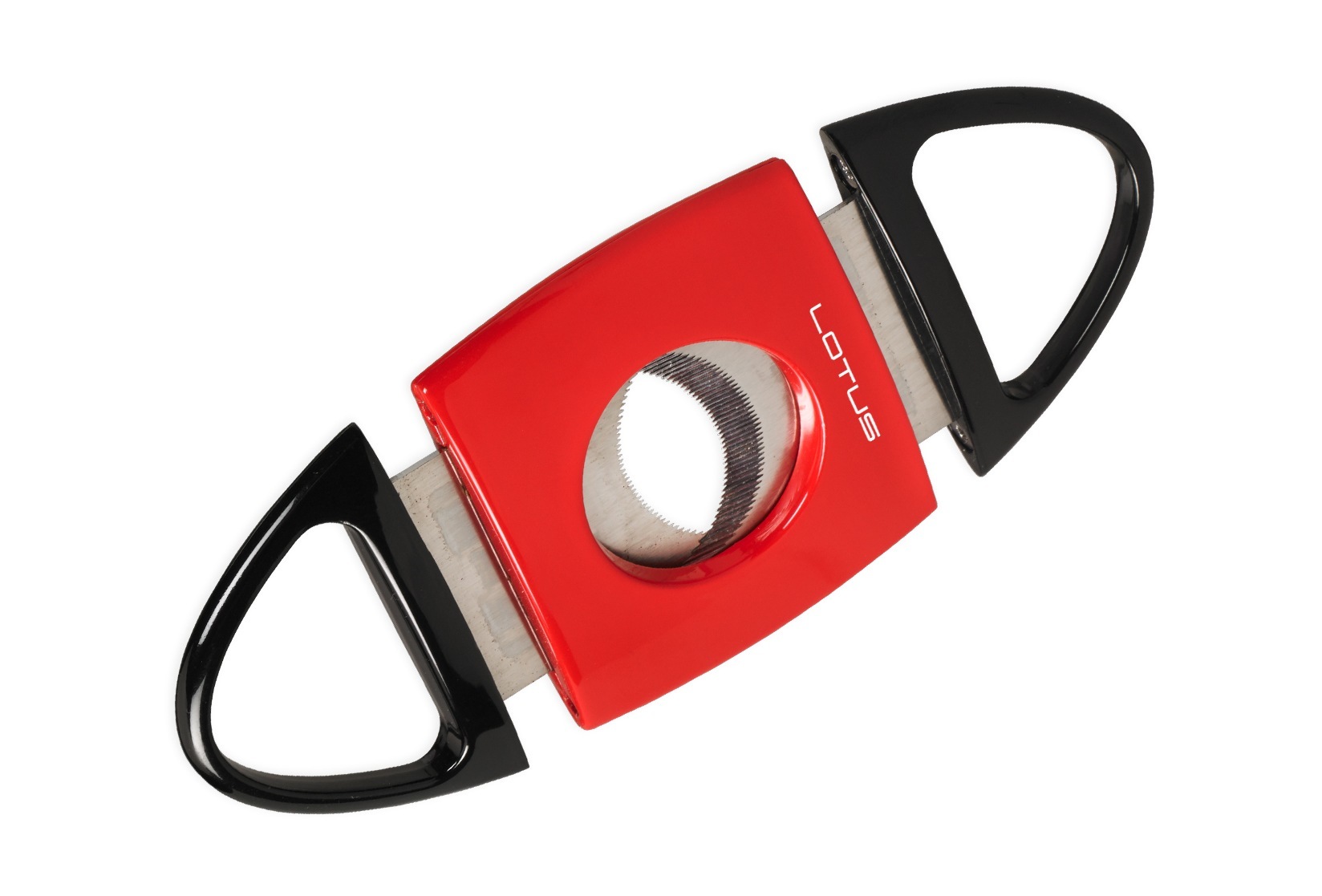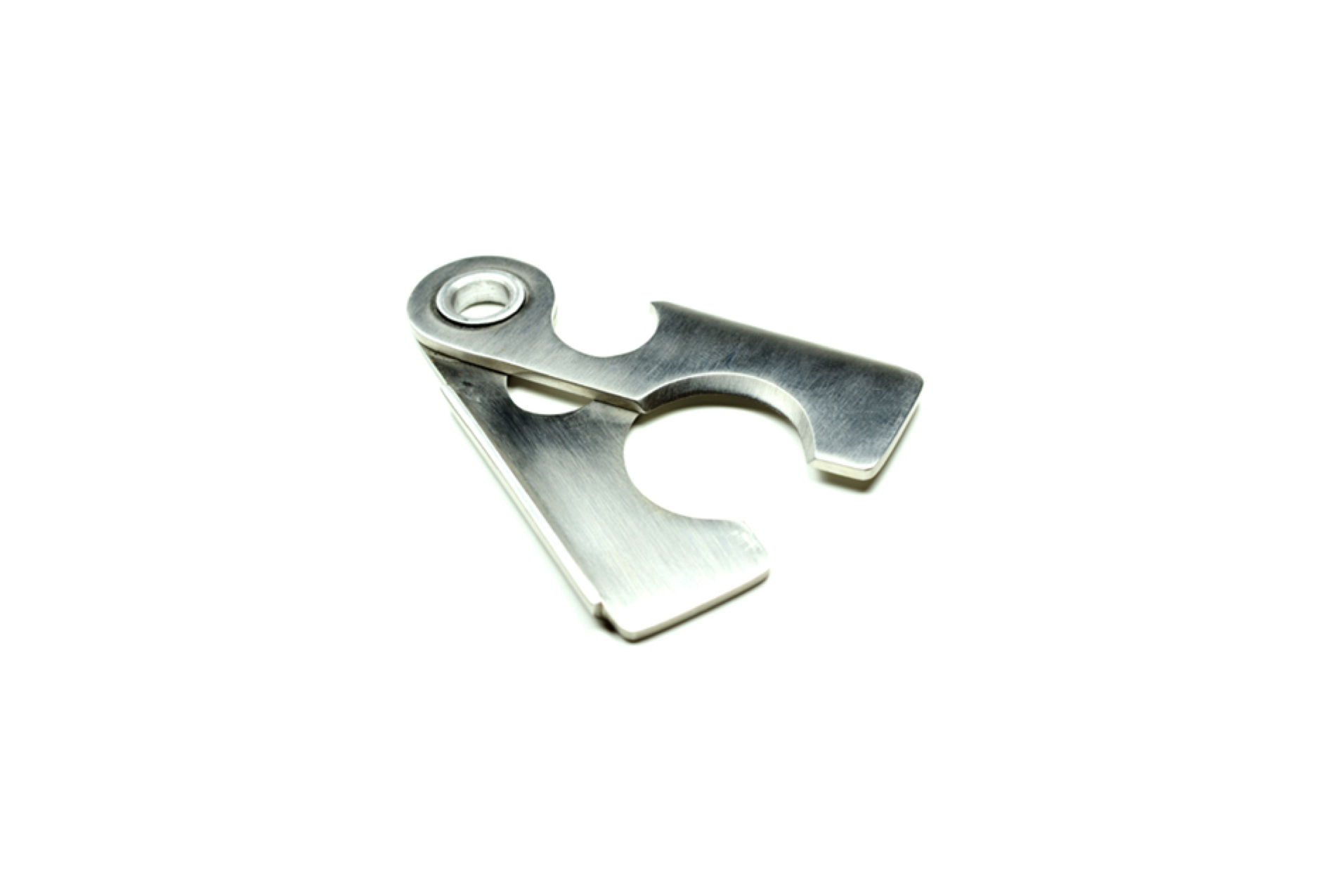When it was originally founded in 1920, El Casco—a name that translates to the helmet from Spanish—was a producer of revolvers that were exported across the globe. However, during the Great Depression, the Spain-based company decided to diversify into other products starting with its M-5 stapler in 1935. In the years since, El Casco has become known as a maker of a number of other higher-end desktop accessories made with components that are individually numbered and assembled by hand, including paper punches, pencil sharpeners, lamps and various clocks.
One of the more unusual products that the company makes is its Cigar Cutter, which is extremely similar in design to the company’s M-85 Plier Stapler.
WHAT IS IT?
Large, heavy and very, very shiny, the El Casco Cigar Cutter is a single guillotine cutter that looks very much like a single hole punch.
The blade is described as Solingen stainless steel, which basically means the metal came from the city of Solingen, the German city best known for its knifemakers. The cutter measures 6.1 inches long and 3.2 inches wide, with a total height of 1.3 inches. According to the company, each of the different models can cut cigars up to 50 ring gauge, although I was able to cut enough of the cap off of cigars up to 56 ring gauge to smoke with no issues.
HOW MUCH DOES IT COST?
There are currently four different versions of the El Casco Cigar Cutter, all of which feature the same design but using different metal platings and finishes:
- El Casco Cigar Cutter (Chrome Plated)— €160 ($190)
- El Casco Cigar Cutter (23 Karat Gold Plated) — €195 ($231)
- El Casco Cigar Cutter (Chrome & Black) — €130 ($155)
- El Casco Cigar Cutter (Black & 23 Karat Gold Plated) — €180 ($213)
HOW DOES IT WORK?
As mentioned above, the El Casco Cigar Cutter features a design that looks like a single hole punch, so if you have ever used one of those, this cutter should be familiar. Like many cutters, you insert the cap of the cigar you are cutting into the small round opening located on the top of the device. While the section behind the opening is slanted downward—i.e. not flat—in order for the cap to have somewhere to fall, the cigar will sit straight when it is placed in the hole.
To operate the cutter, it is then just a simple matter of squeezing the two handles closed—like a single hole punch—which pushes the very thin blade through the cap completely until it stops at the end of its journey. The cut cap then stays inside of the opening—but stuck between the back of the blade and the backplate—until you let go of the handles, which then retracts the blade to its original position and allows the cut cap to fall wherever you direct it to. The backplate does its job well, as it means that you won’t be able to take too much off the cigar in one cut that would deem a cigar unsmokeable.
However, as you squeeze the handles to force the blade through the cap of the cigar, many parts of the cutter move, most notably the cutting head, i.e. the part where you put the cap of the cigar, gets angled upwards. It is not an insignificant amount of shift, meaning that if you don’t compensate for it, you will end up with cuts that are clean, but also far from level, i.e. the angle of the cut won’t be parallel with the foot of the cigar. You can compensate and thus alleviate the issue by pushing in a bit harder on the cigar—but not so hard that you damage the cap—while just being aware of how much the blade is moving. It takes a little time and a few awkward cuts, but after that, it will most likely become second nature.
THE GOOD
- It Cuts Cigars Cleanly. Pretty Much Every Time — The action is extraordinarily smooth and powerful. Combine that with the sharp and extremely thin blade and there were virtually no issues with either the cuts or any damage to the wrappers or cap.
- Mostly Fool-Proof — While the El Casco has visibility issues (see below), the backplate—which measures 5.5mm deep at its deepest point—means it would be extremely difficult to cut off too much off of a cigar that would render it unsmokeable. If you’ve ever watched someone try to cut a cigar for the first time, the most likely scenario is that they will cut off too much and/or have a jerky motion that might also damage the cigar. The El Casco mostly solves both of those issues.
- Built Like A Tank — It is made entirely of metal, and feels like it.
- The Cap Stays Inside Until You Want It To Come Out — A very nice feature that works pretty much every time, regardless of if you are cutting a full cap or—as in the case of a torpedo vitola—sections of the cigar that have already been cut.
THE BAD
- The Cutting Head Moves At Angle As You Are Cutting — Many parts of the cutter move at various angles as you squeeze on the handles, but the most problematic is that the piece that holds the blade and the top of the cigar moves up at an angle from its starting position. The end result can be angled cuts—albeit still clean cuts—until you realize what is happening and compensate for the movement as you are cutting.
- It Has Difficulties Cutting Torpedoes And Cigars Over About 56 Ring Gauge — If you are cutting anything larger than a 56 ring gauge cigar, you are not going to have a great time. As for torpedoes, because you are limited when it comes to how much of the cigar you are cutting off, you will most likely have to cut the cap multiple times. That is not to say you can’t cut cigars with a tapered cap, but the process of cutting down a little further and a little further until you end up with the results you are looking for gets annoying quickly.
- It Is Not Exactly Portable — While I did carry this around in my bag while I was reviewing it, for most people, this is just not going to be a portable option due to the combination of its overall size and significant weight. In fact, YouTuber Kirby Allison—who first mentioned the cutter to me and says it’s his preferred cutter—actually said he was debating bringing it over to our office but showed up without it because of how not portable the El Casco is.
- You Can’t Accurately Gauge How Much You Are Cutting — Since the opening is closed off on the opposite end by the backplate, you can only generally tell where the blade is going to end up cutting through the cap when using the cutter in a normal manner. Having said that, if you turn the cutter 90 degrees so that the opening where the caps are ejected is facing you, it does provide more information on how much of the cap is being cut, albeit still not as exact as you would get using a simple double guillotine cutter.
- Takes A Bit Of Practice In Order To Get Optimum Results — On one hand, the El Casco cutter has a backplate that will stop someone who has never smoked a cigar from cutting off too much, it’s likely going to take a few cuts before they get the hang of it. This means it’s probably not the best for cigar shops since that learning curve may very well lead to customers ending up with less than ideal cuts because they aren’t “flat” cuts. The cuts are technically straight as they don’t curve, but they are angled.
THE COMPETITION
I can’t think of a cigar cutter that is close in design to the El Casco Cigar Cutter. But the Jetline Baron ($279.99) is an expensive and unique single guillotine cutter that isn’t portable. It features its blade attached to a plunger-like mechanism that you push down. While they don’t function the same, the real difference is that the Jetline tends to damage the caps of the cigars it is used on in various ways while the El Casco has no such issues.
Additional Competitors
- Coltellerie Saladini 3000 Series Table Cigar Cutter ($180) — As far as other very unique and not portable single guillotine cutters, this Italian-made cutter includes two different openings, a smaller hole that cuts cigars up to 24 ring gauge and a larger opening that cuts cigars up to 52 ring gauge. The Coltellerie Saladini is both more awkward to use and not even close to as functional as the El Casco. It’s also probably more designed to cut Italian cigars than the types of cigars we typically write about on this site.
- Colibri Quasar Desktop Cutter ($125) — If you want a well-made tabletop cutter that is both visually interesting and extremely functional, this Colibri is a bit more affordable than the El Casco and actually cuts cigars well. Notably, it includes both options for a straight cut and v-cut.
- Table QUAD Cutter by Palío ($125) — Another option for a tabletop cutter, but features four different blades: two v-cutters that can cut up to 58 ring gauge and 52 ring gauge cigars, and two straight cutters that can cut up to 52 ring gauge and 60 ring gauge cigars.
SHOULD YOU BUY IT?
Yes, as long as you don’t expect to carry it around in your pocket.
This cigar cutter cuts caps so consistently well that I started to get bored using it after a little while. As long as the cap is inserted into the opening somewhat correctly, the odds of you getting anything other than a sharp and clean cut are astronomically low, although it is a bit harder to get a cut that is level. Sure, there are a small number of issues—you are not going to be carrying this around in your pocket unless you are a glutton for punishment, you have to work a bit harder to compensate for the blade moving as you squeeze the handles and large ring gauge cigar smokers are pretty much out of luck—but in the end, the El Casco Cigar Cutter is not only one of the most unique cutters I have reviewed, but also performs very, very well.


